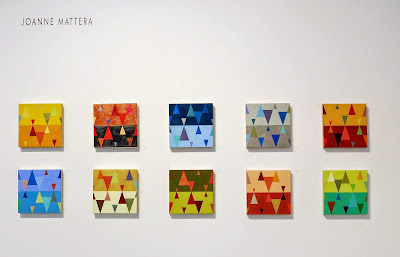I
spend most of my time in Massachusetts during the summer. To feed my art fix I
get to the galleries in and around Boston, sometimes farther afield within the
state. Critical Mass. is the summer series I started a few years ago to share
with you some of what I saw. I reprise it now, and will continue to post
intermittently through August.
The inviting storefront entry to Room 83 Spring
We start with Room 83 Spring, a gallery in Watertown, Mass.—a
city just west Cambridge—founded by two artists, Ellen Wineberg and Cathleen
Daley. Like many artist-run projects, it is a labor of love. Emphasis on labor.
Emphasis on love. Wineberg and Daley’s concept for the gallery is, well, let them tell you: “A
site for experimentation and process, room hosts a mix of creative disciplines,
provocative installations, and engaging exchange. We are artists who
wish to foster and celebrate other artists.”
Housed in a single-story commercial building on a residential street, Room 83 Spring (which shares the structure with Drive By Projects next door, another artist-run venue), typically brings together three to five artists in thematic exhibitions. Because Wineberg and Daley are working artists themselves, Room 83 Spring is open only on Thursday (2:00 to 7:00) and on Saturdays (12:00 to 4:00) and by appointment.
Housed in a single-story commercial building on a residential street, Room 83 Spring (which shares the structure with Drive By Projects next door, another artist-run venue), typically brings together three to five artists in thematic exhibitions. Because Wineberg and Daley are working artists themselves, Room 83 Spring is open only on Thursday (2:00 to 7:00) and on Saturdays (12:00 to 4:00) and by appointment.
Splendor Redux with, from left: Kelley Harwood, Nina Bentley and Kathleen Volp
The current exhibition (up through the end of this week, May
28) is Splendor Redux, a three-artist
show that reconsiders the still life with a contemporary sensibility that
mashes together feminism, poignancy, irony and humor. Nina Bentley and Kelley Harwood use the metaphor and object of the silver serving set, while Kathleen
Volp creates assemblages of cheap overabundance, a contemporary metaphor if ever there was one. It’s a rewarding mix.
Nina Bentley, Corporate Executive Wife's Service Award Bracelet II (Homage to Lorna Wendt), courtesy of the New Britain Museum of American Art
Detail below
In creating the outsize charm bracelet of silver serving vessels, Bentley recalls the story of Lorna Wendt, who, back in the Nineties, was offered 10 percent of the family assets when her husband of 32 years divorced her. Lorna took him to court, arguing that her job in over three decades of marriage was as a partner, the one who maintained the home, raised the children, and sacrificed her own career aspirations. The judge agreed and she ended up with 50 percent of the assets. And she acquired a version of this sculpture.
Kelley Harwood, #7, acrylic on board, 2015
Bentley's metaphor of greedy corporate husband finds its moral opposite in Kelley Harwood's touching story of a sterling silver tea set. "The tea set I paint is a 25th anniversary present from my grandfather to my grandmother. Visiting their house once or twice a year as a child, I remember it with a sense of love, well-being, luxury, generosity and visual richness."
Harwood's small, mostly achromatic paintings are reductive but rich with memory and observation.
Kathleen Volp, White Madonna, 2013, mixed media
Volp's interest is in Seventeenth-Century Dutch still life-painting, specifically a style called pronkstilleven, still-lifes of ostentation. Mining a rich vein of irony, Volp creates assemblages with the abundance of cheap contemporary culture: shiny fabric and plastic fruit. From the front room . . .
. . . we head into the back, where more work by Volp is on view
Homage to the Market Girls, 2014-15, oil and assemblage
Detail below
Artist-created and -run galleries are not huge commercial enterprises. When one springs up in your area, take the time to go. Encourage others to go. Support it. It took me a while to get to Room 83 Spring. I promise I'll be back.




















































































